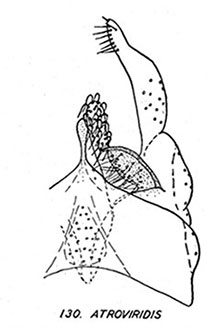Species 2i. Chironomus (Chaetolabis) atroviridis Townes 1945
Tendipes (Chaetolabis) atroviridis - Townes 1945
Chironomus viridicollis - Johannsen 1905, Needham 1908, Branch 1937, all misdeterminations of viridicollis van der Wulp
Chironomus nr. viridicollis - Townes 1937
Chironomus (Einfeldia) viridicollis - Johnannsen 1938
It is possible some of these may refer to C. (Chaetolabis) bitumineus. Adult: Based on description of Townes (1945). Male
Wing length 5.0 mm. LR 1.55, fore tarsus without a beard. AR 4.0 Frontal tubercles small but rather long.
Head brown, clypeus and appendages dark brown.
Thorax ochraceous slightly tinged with green, vittae and posterior part of postnotum dark brown, median vitta divided by a pale line.
Abdomen blackish green, basal part more or less green.
Legs greenish, grading to brown on apical tarsal segments; dark brown at apices of femora, base and apices of tibiae (although some fore tibiae are entirely dark), apex of basitarsus and becoming more extensive on subsequent tarsi.
Hypopygium quite similar to that of C. (Chaetolabis) bitumineus. Pupa: Has not been described. Two characters are known: The cephalic tubercles (below) are long, almost twice as long as wide, with a subapical seta. The caudolateral spur of segment 8 (below) has about 4 closely applied spines.  Larva a medium to large thummi-type, length (male) 16.5 - 17.8 mm. VT about equal, ant. 0.8 - 1.04 mm, post. 0.88 - 0.98 mm long. Gula dark on posterior half, frontoclypeus pale or slightly darkened.
Mentum (Fig. c) as in Chironomus; 4th lateral barely reduced (type I), c1 tooth broad with short diverging sides, c2 teeth only moderately developed, notches about 45° (type IA, sometimes c1 tends to type IIA).
Ventromentum (Fig. d) with about 50 - 54 striae. Antenna (Fig. b) with basal segment about 3.3-35 times as long as wide, Ring organ near middle of segment; AR about 1.80 - 1.85; A2/A1 about 0.27; A3 shorter than A4, and sometimes longer than A5. Pecten epipharyngis (Fig. a) with about 13 - 18 teeth, including 3 or 4 small teeth.
Premandible with inner tooth about 2.8 - 3 times wider than outer tooth, teeth about equal in length or outer tooth slightly shorter.
Mandible (Fig. e) with 3rd inner tooth pigmented and separated (type IIIC), about 19 furrows on the outer surface near the base. Cytology: 4 polytene chromosomes with indications of the thummi chromosome arm combination, AB, CD, EF, G.
Arm G short, generally unpaired with a virtually terminal nucleolus following a constricted chromosome end, then an almost terminal Balbiani ring at other end. No nucleoli in the long chromosomes.
Polymorphism in arms A, C, F, and possibly a small terminal inversion in arm E.
atrA1: Keyl pattern not clear, other than the proximal 16 - 19
atrA2: simple inversion of about the middle half of arm as bitA2?
atrB1:
atrC1:
atrC2: inversion of about half of the arm beginning about 16 bands from the distal end of the arm. as bitC1?
atrD1:
atrE1: possibly 1 - 3e, 10b - 3f. 10c - 13 i.e. basic sequence as luridus, etc.
atrF1: only the proximal bands 20 - 23 can be readily recognized.
atrF2: simple inversion of about the middle half of the arm. as bitF2? DNA analyses:
mtcoxI: GenBank accession numbers KF278329.1-332.1, KF278342.1 & 360.1
gb7: GenBank accession number KF278450. Found: British Columbia - Terrace (Townes 1945).
Manitoba - Southern Indian Lake (Rosenberg et al. 1984).
Ontario - White Lake, Three Mile Bay (48.70, -85.75); Orillia; Point Pelee (last 2, Townes 1945).
Quebec - Lac Marlon, Rouyn-Noranda (48.27, -79.07) (I. Proulx et al. 2013).
Saskatchewan - Oxbow (Townes 1945).
Arkansas - White River National Wildlife Refuge, Arkansas (Chordas et al. 2004.)
Connecticut - Stafford (Townes 1945).
District of Columbia - Washington (Townes 1945).
Idaho - Cataldo (Townes 1945).
Illinois - Urbana (Townes 1945).
Iowa - Crystal Lake, Davenport; Dickinson Co. (Townes 1945).
Massachussetts - Amherst; Edgartown; Holliston; Wellesley (Townes 1945).
Michigan - East Lansing; Iosco Co.; Manistee Co.; Nottawa; Silver Lake, Oceana Co. (Townes 1945).
Minnesota - Cass Lake; Chisago Co.; Crystal Lake; Hennepin Co.; Mendota, Dakota Co. (Townes 1945).
New York - Amsterdam; Bemus Point (Type locality); Canandarago Lake; Ithaca; Mayville; Otsego Lake;
Ringwood, Tompkins Co.; Round Island; Tuxedo (Townes 1945).
Ohio - Summit Co. (Townes 1945).
Virginia - Dyke; Falls Church (Townes 1945).
Some of the Townes (1945) localities may refer to C. bitumineus (sp. 2h), although Townes notes that all samples came from lakes. In lakes, possibly in shallows with vegetation. The adult male was described by Townes (1945). Notes on the larval morphology, cytology and DNA sequence were given by Proulx et al. (2013), and the species was confirmed as C. atroviridis and the cytology further described by Martin (2014).
The shared chromosome banding patterns and the extremely similar COI DNA sequence to that of C. bitumineus (see below), suggestes that recent hybridization has occurred and may still be occurring. DNA analysis: Sequence for the mitochondrial COI and the nuclear gb7A genes are available. The COI sequences are very similar to that of the known C. bitumineus sequence.
GenBank accession numbers:
CO1: KF278329 - 332, KF278342, KF278360
gb7A: KF278450 See also Ch. bitumineus, Ch. ochreatus.[ Return to Index| Go to References ] |

